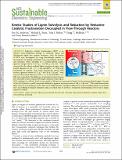Kinetic Studies of Lignin Solvolysis and Reduction by Reductive Catalytic Fractionation Decoupled in Flow-Through Reactors
Author(s)
Anderson, Eric M; Stone, Michael L; Hülsey, Max J; Beckham, Gregg T; Román-Leshkov, Yuriy
DownloadPublished version (1.816Mb)
Terms of use
Metadata
Show full item recordAbstract
© 2018 American Chemical Society. Reductive catalytic fractionation (RCF) is an effective active-stabilization strategy to selectively extract and depolymerize lignin into aromatic monomers. Here, the kinetics of RCF were investigated by using flow-through reactors to decouple the two limiting mechanistic steps, namely lignin solvolysis and reduction. When operating in a solvolysis-limited regime, apparent energy barriers of 63 ± 1 and 64 ± 2 kJ mol-1 were measured for the solvent mediated lignin extraction of poplar using particle diameters of 0.5 < d < 1 mm and 0.075 < d < 0.25 mm, respectively. In contrast, when using mechanically stirred batch reactors, apparent barriers of 32 ± 1 and 39 ± 3 kJ mol-1 were measured for particle diameters of 0.5 < d < 1 mm and 0.075 < d < 0.25 mm, respectively. The difference of activation barriers between flow and batch reactors indicated that lignin extraction under typical RCF conditions in a 100 mL batch reactor stirred at 700 rpm was mass-transfer limited. In the reduction-limited regime, cleavage of the β-O-4 bond in a model compound exhibited an apparent activation barrier of 168 ± 14 kJ mol-1. This study demonstrates RCF occurs by two limiting processes that can be independently controlled. Furthermore, both controlling which process limits RCF and verifying if transport limitations exist, are critical steps to develop a mechanistic understanding of RCF and to design improved catalysts.
Date issued
2018Department
Massachusetts Institute of Technology. Department of Chemical EngineeringJournal
ACS Sustainable Chemistry & Engineering
Publisher
American Chemical Society (ACS)